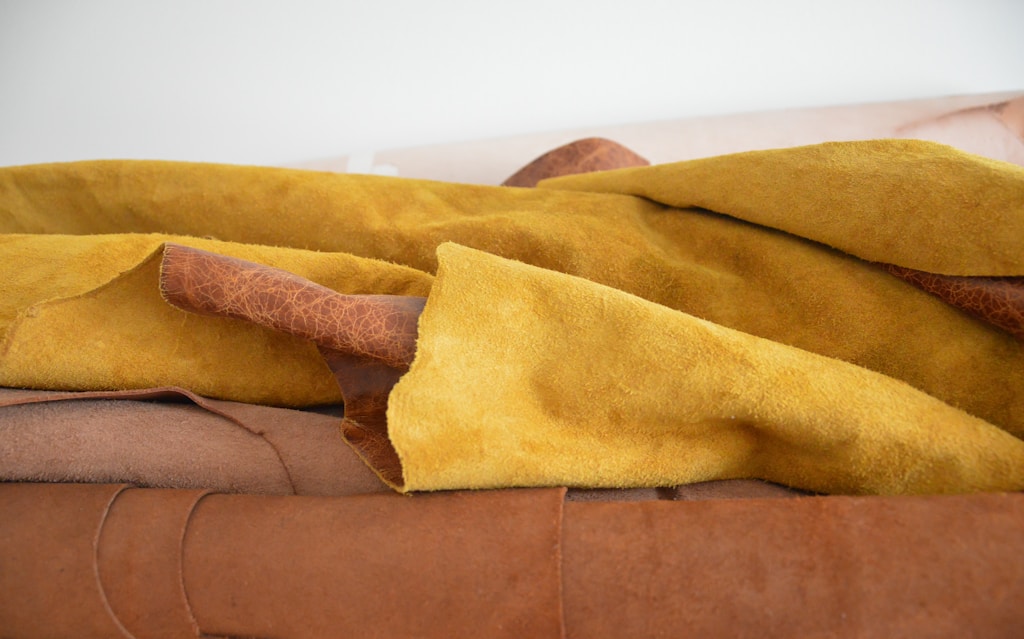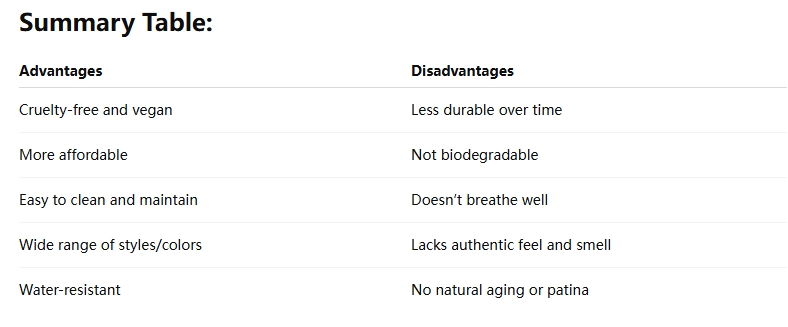Faux leather replicates the appearance of genuine leather through craftsmanship and is completely free of animal components, providing an option for vegan fashion. Although it is inferior to genuine leather in terms of durability and natural aging, it can still present a texture comparable to that of high-end leather with proper maintenance.
The combination of its light luxury attribute and cruelty-free concept has made it a practical material that takes into account both trend and ethics. This article conducts an in-depth analysis of the composition characteristics of faux leather, as well as its advantages and disadvantages, and assesses its core function of durability.
What is faux leather?
Faux leather (also known as synthetic leather/vegan leather) is an artificial material used to imitate the appearance and touch of animal leather without using animal leather. It offers a cruelst-free and affordable alternative to genuine leather, which is widely used in the fields of fashion, furniture and accessories.
Traditional faux leather is usually composed of fabric bases coated with polyurethane (PU) or polyvinyl chloride (PVC), such as polyester or cotton. In recent years, new types of plant-based faux leather (such as mushroom leather and cactus leather) have begun to emerge, becoming an innovative direction for environmental protection. Plant-based leathers (such as cork and apple peel leathers) offer more sustainable and biodegradable alternatives compared to traditional versions.

Advantages and disadvantages of faux leather
The advantages of faux leather
1. No cruelty
Faux leather is 100% cruelty-free and free of animal products, making it a popular choice among vegetarians and ethical consumers.
2. Affordable
It is usually 50-80% cheaper than genuine leather, making it more accessible to both manufacturers and consumers.
3. Various styles
It is easier to dye and create various colors, textures and finishes, which are textures that genuine leather cannot replicate.
4. Low maintenance cost
It is easier to clean than genuine leather – usually just wipe it with a damp cloth. No conditioning or special treatment is required.
5. Waterproof
The PU/PVC coating of faux leather is waterproof and more water-resistant and moisture-proof than natural leather, making it less likely to be stained or damaged in a humid environment.
6. It won’t age or crack like genuine leather
It retains its original appearance for a longer time without developing patina or wrinkles that occur in genuine leather.
7. Environmentally friendly options
Plant-based leathers, such as mushroom and cactus leathers, offer biodegradable alternatives.
8. Consistent quality
Genuine leather may vary in texture and color due to natural defects, while faux leather has consistency in the production process, ensuring consistent quality from batch to batch.
The disadvantages of faux leather
1. Not durable
Faux leather is not durable and not as durable as genuine leather. Over time, it is prone to cracking and peeling, especially when used extensively or exposed to high temperatures and sunlight. The conventional service life is 2 to 5 years.
2. Impermeable
Faux leather absorbs heat and moisture and does not allow air to pass through easily, which may make it uncomfortable in hot or humid conditions.
3. Environmental impact
Traditional faux leather is made of plastics such as PVC or PU, which come from fossil fuels and are non-biodegradable. Harmful chemicals will be released during the production process or decomposition. The new type of plant-based leather does not have this problem.
4. Lack of nature
Faux leather has a plastic feel. Although they look similar, they usually lack the unique texture, softness and smell of genuine leather.
5. No bronze color
Faux leather does not age over time like genuine leather to develop a bronze appearance, which some people consider a drawback.

Suitable consumers:
A thrifty buyer.
Vegetarian/ethical consumers.
Trend-driven, short-term use.
Faux leather is an option in terms of affordability, ethics and design flexibility for light use, but it lacks the lifespan of genuine leather. For sustainable development, choose plant-based faux leather instead of PU/PVC.
How long does faux leather last?
The service life of Faux leather is affected by multiple factors. Generally, its durability is lower than that of natural leather. Under normal use and maintenance, it may last for 2 to 5 years, but it may wear out more quickly under harsh conditions or lack of maintenance.
How long can faux leather be used? Average lifespan:
Low-quality faux leather: It usually takes 1 to 3 years to crack or peel off, especially during daily use.
Medium-grade faux leather (PU-based) : With good maintenance, it can be used for 3 to 5 years.
High-end or premium faux leather (such as microfiber or plant-based leather) : may last for 5 to 10 years, especially with limited wear and tear and proper maintenance.
Factors affecting durability:
1. Material type
PVC (polyvinyl chloride) : It has poor flexibility and is more prone to cracking.
PU (polyurethane) : More flexible and breathable, with a longer duration than PVC.
Microfiber or plant-based leather (such as cactus or mushroom leather) : newer, more durable and more environmentally friendly alternatives.
2. Usage
Frequent daily use (such as on furniture or bags) will accelerate wear and tear.
Occasional or gentle use can extend the service life.
3. Environmental conditions
High temperatures, direct sunlight and humidity will accelerate drying and cracking.
Keeping faux leather away from extreme environments can extend its service life.
4. Maintenance
Regular cleaning and avoiding the use of irritating chemicals can help extend lifespan.
Using a protective agent or conditioner designed for faux leather can also be helpful.

How to extend durability?
Gently clean with a damp cloth and mild soap.
Use silicon-free protective agents.
Avoid direct sunlight and heat.
Is faux leather good for bag?
Yes, faux leather is an excellent material for making bags, especially suitable for creating products with a vegetarian style or an eco-friendly theme. Its advantages lie in low cost and strong plasticity. It can not only imitate the texture of rare leather but also create unique designs. Moreover, it is easy to clean and maintain, meeting the demands of a fast-paced life.
However, its durability is relatively poor. It is prone to cracking or fading after long-term use, and its breathability is also inferior to that of natural leather, which may affect the user experience. If a brand positioning pursues cost performance, fashion diversity or environmental protection concepts, faux leather is an ideal choice.
If you plan to launch a custom business of faux leather bags, leatherbagfactory.com will be your ideal partner. We focus on providing brands with one-stop solutions from design to mass production, offering OEM/ODM cooperation models to meet the full-process requirements from design drafts to finished products.
Related customized services: